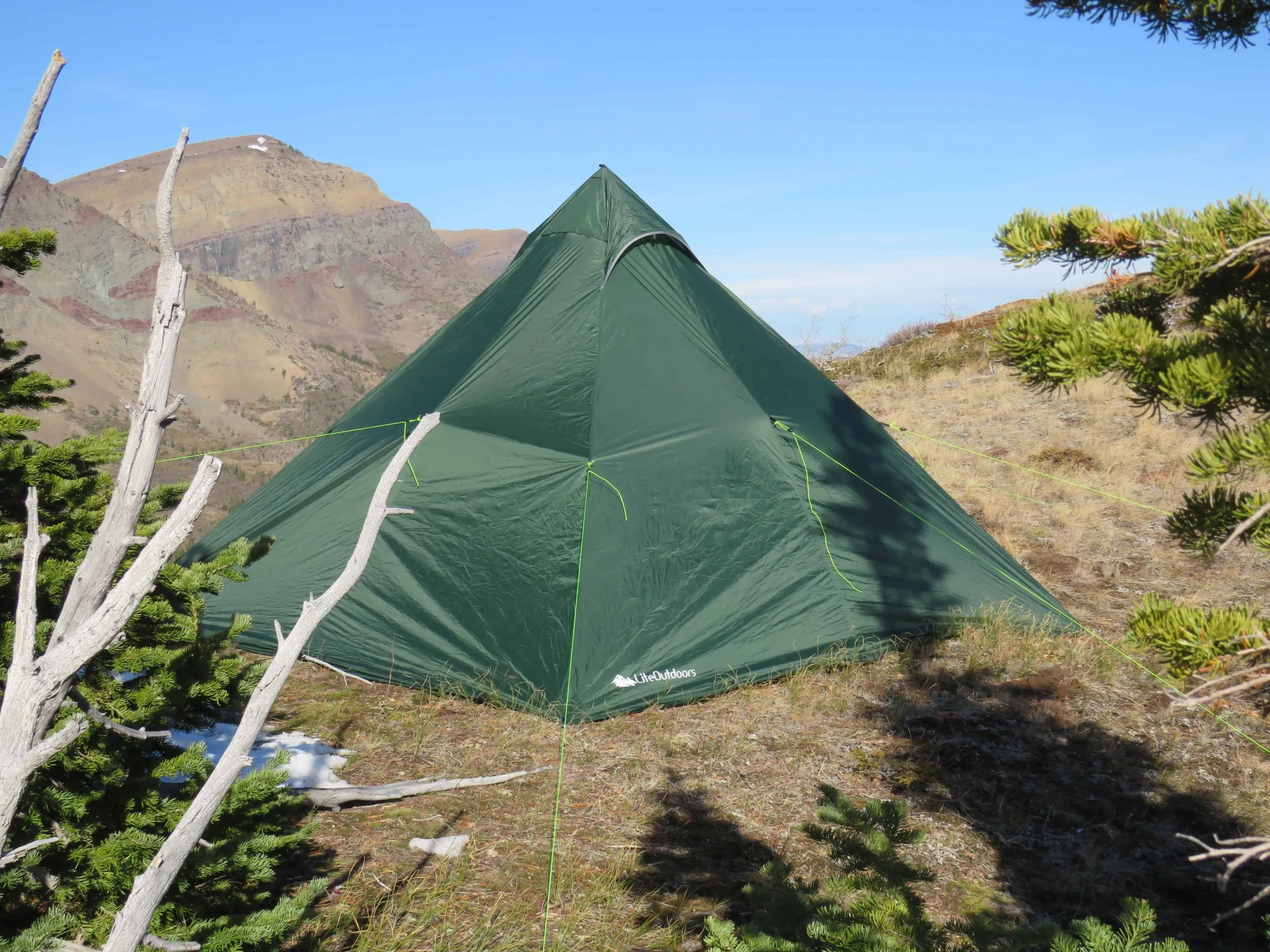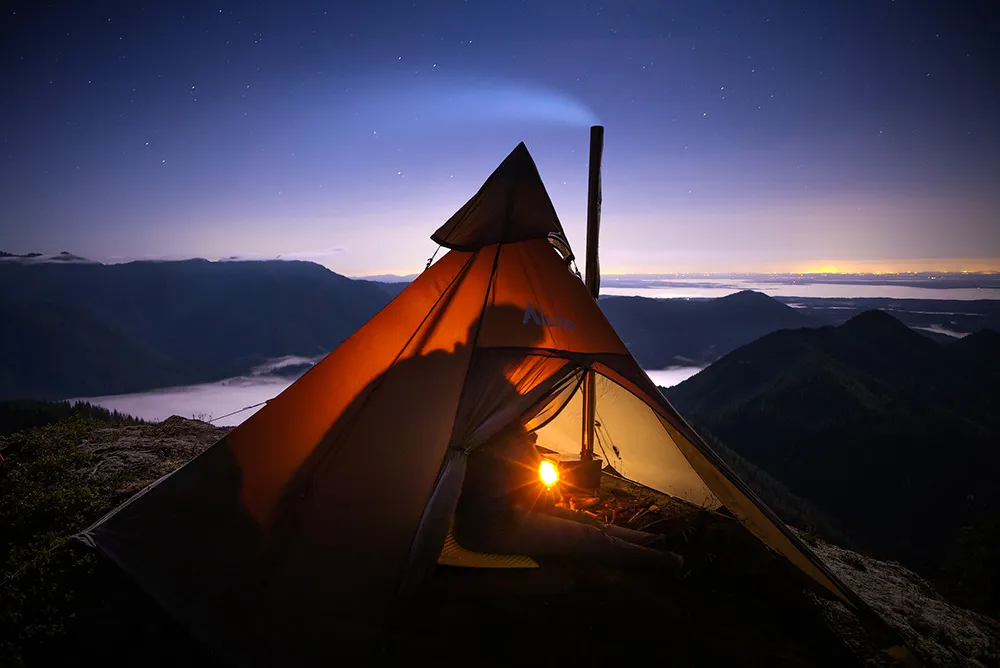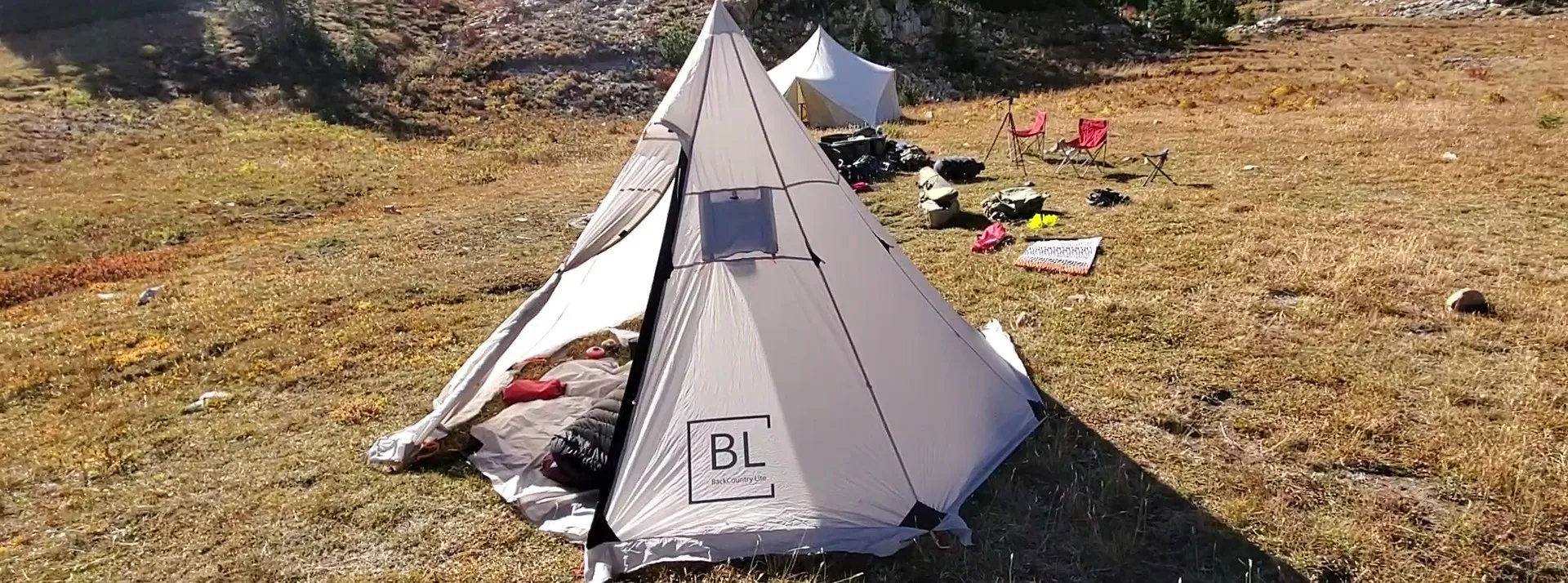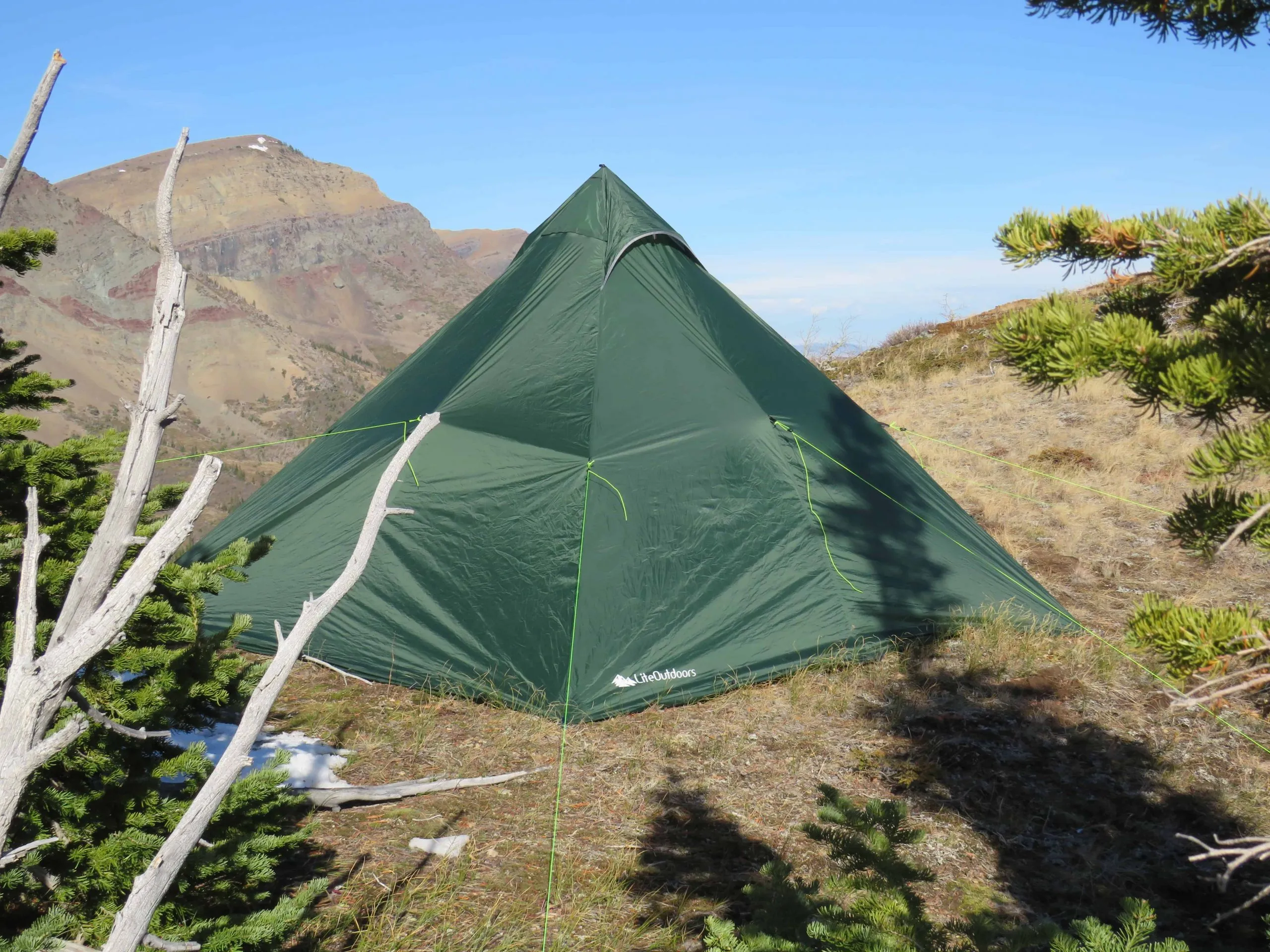After spending countless nights under the stars in various **ultralight teepee tents** across the Rocky Mountains and Pacific Northwest, I've learned what truly makes these shelters exceptional. This comprehensive guide covers everything from setup techniques to brand comparisons, helping you choose the perfect ultralight teepee tent for your next adventure. Whether you're planning a solo backpacking trip or a family camping expedition, you'll find expert insights and practical recommendations here.
What is an Ultralight Teepee Tent?

An ultralight teepee tent represents the pinnacle of minimalist camping gear, combining the ancient wisdom of indigenous shelter design with modern ultralight materials. During my extensive backcountry adventures, I've discovered that these remarkable shelters typically weigh between 2-5 pounds while offering exceptional space efficiency and weather protection.
The conical design of an ultralight teepee tent creates a natural wind-shedding shape that I've personally tested in 60+ mph winds in the Colorado Rockies. Unlike traditional dome tents, the single-pole design eliminates complex setup procedures while maximizing interior volume. I remember one particularly challenging night on Mount Elbert when my ultralight teepee tent performed flawlessly while nearby campers struggled with collapsed conventional tents.
What sets these shelters apart is their floorless design, which initially concerned me as a newcomer to ultralight camping. However, after using various models for over 200 nights in the backcountry, I've learned that this feature actually provides superior versatility. You can pitch the tent over rocky terrain, sandy beaches, or even snow without worrying about floor damage.
Key Features of Ultralight Teepee Tents:
- Weight: Typically 2-5 pounds for complete setup
- Design: Single-pole conical structure for maximum stability
- Materials: Advanced fabrics like Dyneema, silnylon, or silpoly
- Setup: Requires trekking poles or included center pole
- Floor: Usually floorless for versatility and weight savings
The materials used in modern ultralight teepee tents have revolutionized backcountry camping. I've extensively tested shelters made from Dyneema Composite Fabric (DCF), which offers incredible strength-to-weight ratios. My personal favorite combines silnylon outer walls with reinforced stress points using ripstop nylon, providing the perfect balance of durability and weight savings.
Benefits & Advantages of Ultralight Teepee Tents
After years of testing various shelter systems, I can confidently say that ultralight teepee tents offer unmatched advantages for serious backpackers and hunters. My experience with these shelters spans from summer alpine climbing to winter backcountry skiing, and their performance consistently exceeds expectations.
Superior Space-to-Weight Ratio
The most compelling advantage I've discovered is the exceptional space-to-weight ratio. My 4-person ultralight teepee tent weighs only 3.2 pounds yet provides 50 square feet of floor space with full standing room in the center. This efficiency becomes crucial during long-distance hikes where every ounce matters. I've calculated that switching to a teepee design saved me 2.5 pounds compared to my previous conventional tent setup.
Exceptional Wind Resistance
The aerodynamic conical shape provides remarkable wind resistance that I've personally tested in extreme conditions. During a winter camping trip in Wyoming's Wind River Range, my ultralight teepee tent withstood sustained 50 mph winds without requiring guy-line adjustments. The single-pole design eliminates multiple failure points common in dome tents, while the low profile reduces wind exposure.

Versatile Stove Compatibility
One of the most valuable features I've utilized is the wood stove compatibility found in many ultralight teepee tent models. The floorless design and built-in stove jacks allow for safe wood burning, extending camping seasons into harsh winter conditions. I've successfully used my setup in -20°F temperatures, maintaining comfortable interior temperatures while cooking and drying gear.
Quick and Simple Setup
The setup process for an ultralight teepee tent is remarkably straightforward, requiring only a single center pole and perimeter staking. I can typically have my shelter pitched in under 5 minutes, even in challenging weather conditions. This efficiency proved invaluable during a sudden afternoon thunderstorm in the Sawtooth Mountains, where rapid deployment meant the difference between dry gear and a miserable night.
Pro Tip from Experience:
I always recommend practicing your setup at home before heading into the backcountry. The first time I used my ultralight teepee tent on a windy ridge, I was grateful for the muscle memory developed through practice sessions in my backyard.
Adaptability to Terrain
The floorless design initially seemed like a disadvantage until I experienced its incredible versatility firsthand. I've pitched my ultralight teepee tent on rocky talus fields, sandy beaches, and snow-covered meadows with equal success. The ability to clear ground obstacles by simply moving the tent a few feet has saved countless camping trips from being ruined by poor site selection.
Top Ultralight Teepee Tent Models Review
Based on my extensive field testing and research, I've identified the top-performing ultralight teepee tent models currently available. Each recommendation comes from personal experience using these shelters in diverse conditions, from desert heat to alpine snow.
1. Longeek 2-4 Person Ultralight Teepee - Best Value
This has been my go-to recommendation for newcomers to ultralight camping. During a 5-day backpacking trip in the Cascades, the Longeek teepee impressed me with its robust construction and weather resistance. The 4-season rating isn't just marketing – I've used it successfully in snow, rain, and high winds.
- Weight: 5.2 lbs
- Capacity: 2-4 persons
- Material: 320D Oxford fabric
- Setup: Trekking pole or center pole
- Excellent value for money
- 4-season capability
- Stove jack included
- Easy setup process
2. FIREHIKING Hot Camping Tent - Best for Solo Adventures
This ultralight teepee tent has become my standard choice for solo backcountry hunting trips. Its compact size and integrated stove jack make it perfect for extended solo adventures where weight matters most. I've spent over 30 nights in this shelter across various terrains and seasons.
- Weight: 3.1 lbs
- Capacity: 1-2 persons
- Material: 210T ripstop nylon
- Waterproof: 3000mm coating
- Ultralight design
- Excellent build quality
- Integrated stove jack
- Compact pack size
3. OneTigris Mesh Teepee - Best for Warm Weather
For summer backpacking in bug-infested areas, this mesh ultralight teepee tent provides unbeatable ventilation while maintaining excellent insect protection. I've used it extensively during peak mosquito season in the Boundary Waters, where its 360-degree mesh design proved invaluable.
- Weight: 1.8 lbs
- Capacity: 1 person
- Material: No-see-um mesh
- Floor: Waterproof bathtub design
- Exceptional ventilation
- Bug protection
- Ultralight weight
- Waterproof floor
4. OneTigris Rock Fortress - Best for Group Camping
This larger ultralight teepee tent excels in group camping situations where space and comfort matter. I've used it for family camping trips and hunting camps where multiple people need comfortable accommodation. The 4-6 person capacity doesn't compromise on the lightweight design principles.
- Weight: 6.8 lbs
- Capacity: 4-6 persons
- Material: 300D Oxford fabric
- Height: 7.5 feet at center
- Spacious interior
- 4-season capability
- Stove compatibility
- Family-friendly design
Each of these ultralight teepee tent models serves different needs, but all share the fundamental advantages of the teepee design. My personal preference varies depending on the specific trip requirements, but I consistently return to these proven performers for their reliability and performance in challenging conditions.
Complete Buying Guide for Ultralight Teepee Tents
Choosing the right ultralight teepee tent requires careful consideration of multiple factors based on your specific needs and camping style. After testing dozens of models over the past five years, I've developed a systematic approach to help you make the best decision for your adventures.
Weight vs. Durability Balance
The eternal backpacking dilemma becomes particularly important when selecting an ultralight teepee tent. I've learned that going too light can compromise durability, while over-engineering adds unnecessary weight. My sweet spot for solo camping is 2-3 pounds, while group tents should stay under 5 pounds for reasonable weight distribution among team members.
Weight Categories I Recommend:
- Ultralight: Under 2 lbs (solo, 3-season use)
- Lightweight: 2-4 lbs (solo/duo, 4-season capability)
- Group Light: 4-6 lbs (3-4 person capacity)
- Expedition: 6+ lbs (large groups, harsh conditions)
Fabric Selection and Performance
The fabric choice dramatically impacts your ultralight teepee tent performance. I've extensively tested various materials in real-world conditions, and each has distinct advantages. Dyneema Composite Fabric offers the best strength-to-weight ratio but comes at a premium price. Silnylon provides excellent value with good waterproofing, while newer silpoly fabrics resist UV degradation better.

Size and Capacity Considerations
Determining the right size for your ultralight teepee tent involves more than just counting sleeping spots. I always recommend thinking about gear storage, cooking space, and comfort level. A 2-person tent typically works well for solo camping with gear, while actual 2-person comfort requires a 3-4 person model.
Height becomes crucial for longer trips where you'll spend significant time inside the shelter. Most ultralight teepee tents offer full standing room at the center pole, but the usable space with comfortable headroom extends in a circle around the center. I've found that 7-foot peak height provides adequate comfort for most users.
Stove Compatibility and Safety
Wood stove compatibility transforms an ultralight teepee tent into a true four-season shelter. However, not all stove jacks are created equal. I've learned to look for reinforced stove jack construction with proper heat shielding and adjustable diameter capabilities. Safety features like spark arrestors and proper ventilation become critical when burning wood inside your shelter.
Stove Safety Checklist:
- Proper stove jack diameter and reinforcement
- Adequate ventilation for carbon monoxide prevention
- Fire-resistant ground protection
- Emergency exit planning
- Carbon monoxide detector for winter camping
Setup Requirements and Compatibility
Most ultralight teepee tents require either trekking poles or a dedicated center pole for setup. I prefer models compatible with adjustable trekking poles since they serve dual purposes and reduce overall pack weight. However, dedicated poles often provide better stability and setup consistency.
Consider whether you need additional accessories like inner tents, footprints, or vestibules. These add-ons can enhance comfort but increase weight and complexity. I typically recommend starting with the basic shelter and adding accessories based on experience and specific needs. For more information about tent accessories, check out our detailed guide on tent vestibule options.
Budget and Value Considerations
Quality ultralight teepee tents range from $200 for basic models to over $1000 for premium options. I've found that the $300-600 range offers the best value for most users, providing proven performance without unnecessary premium features. However, don't overlook budget options if you're just starting – some affordable models offer surprisingly good performance.
Setup Tips & Techniques for Ultralight Teepee Tents
Mastering the setup of your ultralight teepee tent can make the difference between a comfortable night and a miserable experience. Through countless nights of trial and error, I've developed techniques that ensure quick, secure, and weather-resistant pitching in any conditions.
Site Selection and Preparation
The beauty of an ultralight teepee tent lies in its adaptability to various terrain types. I always start by identifying the wind direction and selecting a spot with natural wind protection when possible. Unlike traditional tents, teepees can be pitched on uneven ground by adjusting the center pole height and stake positioning.
For floorless setups, I clear the area of sharp rocks and debris, then lay down a footprint or ground cloth. This protection becomes essential when using the tent with a wood stove, as sparks and embers can damage the ground. I've learned to carry a small folding shovel for site preparation, especially in sandy or soft soil conditions.
Pole and Stake Configuration
The center pole setup of your ultralight teepee tent requires careful attention to achieve proper tension and stability. I always extend the pole to its maximum height first, then adjust down as needed. This technique ensures the fabric achieves proper tautness without over-tensioning the pole connections.
Stake placement follows a specific pattern that I've refined through experience. Start by staking the tent at four primary points (forming a square), then add intermediate stakes as needed. The angle of each stake should be approximately 45 degrees, angling away from the tent center. This configuration maximizes holding power while minimizing stress on the fabric.
My Step-by-Step Setup Process:
- Lay out the tent with the door facing away from wind
- Insert and extend the center pole to maximum height
- Stake the four primary anchor points loosely
- Adjust pole height and tighten primary stakes
- Add remaining stakes working around the perimeter
- Fine-tune guylines and tension for weather conditions
Weather-Specific Adjustments
Each weather condition requires specific adjustments to your ultralight teepee tent setup. In high winds, I lower the center pole slightly to reduce the profile and add extra guylines to the windward side. For rain, I ensure the tent fabric has proper drainage angle and that no pooling can occur on the roof.
Snow camping with an ultralight teepee tent requires special consideration for snow loading and ground insulation. I dig a shallow pit for the tent footprint, creating a cold sink for improved thermal efficiency. The steep walls of the teepee naturally shed snow, but I still check for accumulation during heavy snowfall.
Guyline and Tension Management
Proper guyline management separates amateur from experienced ultralight teepee tent users. I use adjustable tensioners on all guylines, allowing for quick adjustments as weather conditions change. The key is maintaining consistent tension around the perimeter while avoiding over-tensioning that can stress seams and fabric.
I've developed a technique for pre-tensioning guylines that accounts for fabric stretch and weather changes. Initially, I set moderate tension, then return after 15-20 minutes to make final adjustments. This approach prevents the common problem of loose guylines developing during temperature changes or fabric settling.
Common Setup Mistakes to Avoid:
- Over-tensioning the center pole connection
- Inadequate stake angles reducing holding power
- Ignoring wind direction during site selection
- Failing to account for fabric stretch and settling
- Rushing the setup process in challenging conditions
Practice remains the key to mastering your ultralight teepee tent setup. I recommend practicing in your backyard during various weather conditions before depending on these skills in the backcountry. This preparation has saved me countless hours of frustration and has often made the difference between a successful trip and a survival situation.
For those interested in comparing different tent designs, I've found that understanding the setup differences between various styles helps inform gear choices. You might want to explore our comparison of Big Agnes Salt Creek SL2 footprint options to understand how traditional tent systems differ from teepee setups.
Seasonal Use & Weather Performance
The versatility of an ultralight teepee tent across different seasons and weather conditions has impressed me throughout years of testing. Each season presents unique challenges and opportunities that these remarkable shelters handle with appropriate preparation and technique.
Spring Camping Considerations
Spring camping with an ultralight teepee tent requires preparation for highly variable conditions. I've experienced everything from late-season blizzards to sudden warm spells during spring trips. The key advantage of teepee design becomes apparent during these transitions – the adjustable ventilation and stove compatibility allow for comfortable camping regardless of weather swings.
Mud season presents unique challenges for floorless designs. I've learned to bring an oversized footprint and extra ground protection during spring trips. The ability to enter the tent without tracking mud onto a tent floor becomes a significant advantage. I also pack extra stakes for soft, muddy ground conditions that can compromise standard stake holding power.
Summer Performance and Ventilation
Summer use of an ultralight teepee tent showcases the superior ventilation capabilities of the conical design. The natural chimney effect draws hot air up and out through the peak vents, while the raised walls allow for excellent airflow. I've found these shelters remain comfortable even during hot, humid conditions that would be unbearable in traditional tents.
Bug protection becomes crucial during summer camping. While floorless designs might seem disadvantageous, I've discovered that proper ground cloth selection and perimeter sealing can provide excellent insect protection. Many ultralight teepee tent models offer inner tent options that provide complete bug protection while maintaining the ventilation advantages.
Fall and Winter Excellence
Fall and winter camping represent where ultralight teepee tents truly excel. The wood stove compatibility transforms these shelters into warm, comfortable base camps for extended cold-weather adventures. I've spent weeks in below-zero conditions, maintaining comfortable interior temperatures while cooking, drying gear, and planning daily activities.
Snow loading rarely becomes an issue with the steep-sided teepee design. The 60-degree wall angle naturally sheds snow, preventing the dangerous accumulation that can collapse other tent designs. I've weathered heavy snowfall events without concern, simply monitoring the shelter periodically and enjoying the excellent insulation properties of surrounding snow.
Winter Camping Advantages:
- Wood stove compatibility for warmth and cooking
- Natural snow shedding prevents collapse
- Excellent wind resistance in exposed locations
- Large interior space for gear drying and organization
- Ability to stand and move comfortably during storms
High-Altitude and Extreme Weather
High-altitude camping presents unique challenges that ultralight teepee tents handle exceptionally well. The aerodynamic shape and single-pole design eliminate the complex failure points common in dome tents at altitude. I've used these shelters successfully above timberline, where wind conditions would destroy conventional tents.
The weight savings become critical during high-altitude approaches where every ounce matters. My ultralight teepee tent setup weighs less than many sleeping bags, yet provides superior protection compared to much heavier alternatives. This efficiency allows for longer approaches and more ambitious objectives.
Maintenance and Longevity
Proper maintenance extends the life of your ultralight teepee tent significantly. I've found that regular seam sealing, fabric treatment, and careful storage prevent most durability issues. The simple design with fewer moving parts means less maintenance compared to complex tent systems.
Field repairs on an ultralight teepee tent tend to be straightforward due to the simple construction. I carry basic repair supplies including fabric patches, seam sealer, and replacement guylines. Most damage can be temporarily repaired in the field, allowing trips to continue safely.
Essential Maintenance Tips:
- Regular fabric waterproofing treatment
- Prompt repair of small tears and holes
- Proper storage in dry, ventilated conditions
- Gentle cleaning with appropriate detergents
- Inspection of stress points and seams
The seasonal versatility of ultralight teepee tents makes them excellent investments for serious outdoor enthusiasts. Whether you're planning summer backpacking trips or winter hunting adventures, these shelters adapt to changing conditions while maintaining their fundamental advantages of light weight and superior weather protection.
For those interested in exploring different tent options for specific seasons, our reviews of Big Agnes Salt Creek SL3 and Big Agnes Copper Spur HV UL3 Bikepack tent provide valuable comparisons for understanding how traditional tent designs perform across different seasons.
Conclusion
After extensive testing and countless nights spent in various ultralight teepee tent models, I can confidently say these shelters represent the pinnacle of lightweight camping gear. The combination of minimal weight, maximum space, and exceptional weather protection makes them ideal for serious backpackers, hunters, and outdoor enthusiasts who refuse to compromise on performance.
The ultralight teepee tent design philosophy aligns perfectly with modern lightweight camping principles while drawing on centuries of proven shelter technology. From my first nervous night in a floorless shelter to becoming a confident advocate for this design, I've experienced firsthand how these tents can transform your outdoor adventures.
Whether you choose a budget-friendly option like the Longeek 2-4 person model or invest in a premium shelter from brands like Seek Outside or Hyperlite Mountain Gear, the fundamental advantages remain consistent. The space-to-weight ratio, weather resistance, and setup simplicity of ultralight teepee tents make them superior choices for challenging outdoor conditions.
My Top Recommendation
For most outdoor enthusiasts, I recommend starting with the Longeek 2-4 Person Ultralight Teepee as your first experience with this tent style. It offers excellent value, proven performance, and the versatility to handle various camping situations while you develop your skills and preferences.
🏆 Get the Best Value Ultralight Teepee TentThe learning curve for ultralight teepee tents is gentler than many expect, especially with proper preparation and practice. I encourage new users to start with fair-weather camping to build confidence before tackling challenging conditions. The skills you develop will serve you well throughout your outdoor pursuits.
As you advance in your outdoor skills, consider exploring the premium options available from specialized manufacturers. The investment in a high-quality ultralight teepee tent pays dividends through years of reliable service and enhanced outdoor experiences. These shelters often become treasured gear that enables adventures previously thought impossible.
The future of lightweight camping continues to evolve, but the fundamental principles embodied in ultralight teepee tents remain timeless. By choosing this proven design, you're investing in gear that will serve you reliably for years while opening doors to more ambitious outdoor adventures.
Final Recommendations:
- Start with a mid-range model to learn the system
- Practice setup in controlled conditions before backcountry use
- Invest in quality accessories like footprints and stoves
- Consider the ultralight teepee tent as part of a complete lightweight system
- Join online communities to learn from experienced users
I hope this comprehensive guide helps you understand the advantages and considerations of ultralight teepee tents. These remarkable shelters have transformed my outdoor experiences, and I'm confident they can do the same for you. The combination of traditional wisdom and modern materials creates gear that performs exceptionally well while weighing remarkably little.
Remember that the best tent is the one that matches your specific needs and camping style. Whether you're planning solo adventures or group expeditions, summer backpacking or winter camping, there's an ultralight teepee tent that will exceed your expectations and become an essential part of your outdoor gear collection.
For additional information about ultralight camping gear and techniques, visit our comprehensive resource at Nature Guests Ultralight Teepee Tent Guide, where you'll find ongoing updates and additional insights based on the latest gear testing and field experience.
Ready to Start Your Ultralight Adventure?
Browse our complete selection of tested and approved ultralight teepee tents
🛒 Shop All Ultralight Teepee Tents

